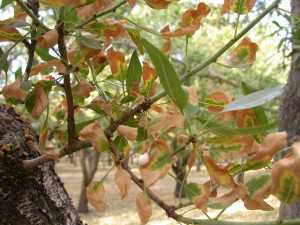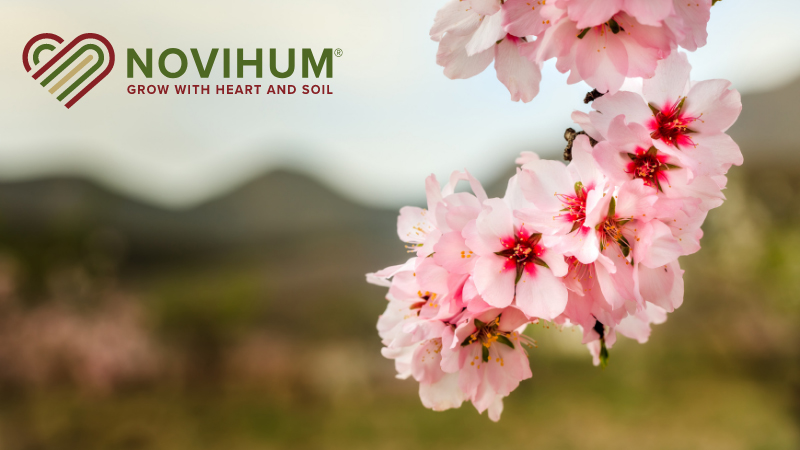How To Control Almond Leaf Scorch

Photo credit: Brent Holtz, University of California
In late summer, several PCAs and growers reported trees in almond orchards in the Sacramento Valley with symptoms similar to those of almond leaf scorch (ALS) — a disease caused by the bacterium Xylella fastidiosa. Five of six fresh leaf samples subsequently submitted to a lab for ALS evaluation tested positive for Xylella fastidiosa.
Symptoms
The bacteria live in the xylem, the water transporting structures in plants, and reduce the flow of water to leaves. Leaf tissue dies when xylem plugging — due to bacteria presence — results in insufficient water arriving at the leaf margins. Almond leaf scorch symptoms first appear on individual leaves in early June to mid July. The leaf tips or margins initially turn light gray-green. The scorching occurs with the onset of hot weather.
By late July, symptoms are fully developed and are most noticeable. It is important to identify and mark affected trees while the scorched areas of the tree canopy contrast clearly with healthy green leaves. Once harvest begins, mites, dust, and drought stress combined with tree shaking often make signs of almond leaf scorch difficult to detect.
Scorch symptoms first appear in a branch, scaffold, or portion of the tree, but will subsequently spread to affect the entire tree. The rate of symptom spread from when first visible to infecting the entire tree can occur slowly over several years, or relatively fast, infecting the entire tree from one season to the next. Regardless, the disease will infect more of the tree with each succeeding year. It may be easily overlooked when only a few leaves on one branch are affected. Almond leaf scorch is also known as Golden Death because of the striking yellow color of a fully infected tree’s canopy. Within a few years, affected trees lose vigor, become unproductive, and may eventually die.
Variety Susceptibility
Varieties that appear more susceptible in the field include Peerless, Sonora, Winters, Livingston, and Wood Colony. Nonpareil is also susceptible and can be significantly affected. The disease is rare in Carmel and Butte and is seen less often in other varieties.
Pathogen And Vectors
Almond leaf scorch and Pierce’s disease of grapevines are caused by the same bacterium, Xylella fastidiosa, although there are almond and grape strains of the disease that can both be found in almond. The disease presents a potentially serious threat to California almond orchards since it is spread by sharpshooter leafhoppers which feed in the water conducting xylem. These insects carry the pathogen from plant to plant, and common annual weeds in the orchard can be sources of infection. At this time, there is no evidence that infected trees are the source of bacteria to infect other trees, but sharpshooters feeding on infected trees can infect annual weeds, and sharpshooters feeding on the infected annual weeds can infect additional trees in the orchard. Irrigated pasture, weedy grasses, alfalfa, and permanent cover crops are the most common habitat for sharpshooters in almond growing regions of California.
The green sharpshooter, Draeculacephala minerva, and the red-headed sharpshooter, Carneocephala fulgida, are the most common vectors of the pathogen found in almond orchards. The glassy-winged sharpshooter, Homalodisca coagulata, could also successfully spread the pathogen in almond orchards because, unlike other known vectors, it prefers to feed on trees. The small, green potato leafhopper (Empoasca sp.), prune leafhopper (Edwardsiana prunicola), and the white apple leaf hopper (Typhlocyba pomaria) that commonly feed on almond leaves are not vectors of this disease.
What To Do
No chemical or nutritional treatments control almond leaf scorch. In addition, no research or practical experience suggests that disease occurrence is reduced by controlling the vectors with insecticides. If you suspect that a tree may be infected, first test its leaf tissue for excess salts, particularly chloride and sodium.
Salt injury, especially chloride burn, may be mistaken for almond leaf scorch. Sometimes the two are indistinguishable. With salt damage, there is usually just healthy, green tissue and dead, brown tissue without the yellow margin between the healthy and dead tissue.
Salt injury may occur at any time but often worsens as the growing season progresses. Ordinarily, it is a result of excess salinity in soil or water. Unlike almond leaf scorch, salt injury affects numerous trees in one concentrated area rather than individual trees widely scattered throughout an orchard.
If sodium and chloride levels are normal, and salinity has been eliminated as a possible cause of the problem, you may wish to have the tree tested for leaf scorch. The best time to test for almond leaf scorch is July through September.
The same testing practices and labs that can detect Xylella fastidiosa in grapes can be used for testing almond leaves for ALS. The cost per sample runs from approximately $150 to $400 depending on the lab and the number of tests run.
In young orchards less than 10 years old, early identification and removal of diseased trees may minimize the problem and reduce further tree losses. If your orchard is 18 to 20 years old, you may want to simply live with some infected trees until the orchard is removed and replaced. Orchards between 10 and 18 years old are the difficult call — do you remove the infected trees or live with the problem? The answer to this question may depend on what’s around the infected block. If infected trees jeopardize a newly planted nearby orchard, then removing the trees might be the best course.
We’ve tried pruning out early infections in single infected scaffolds but the cuts must be made at least 5 feet below the lowest symptomatic leaves to have any chance to save the rest of the tree. Be sure to mark trees if you attempt to prune out the disease and re-inspect the tree the following year.









